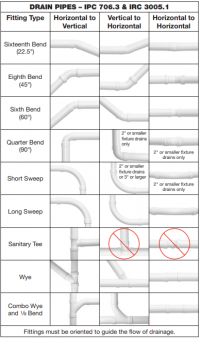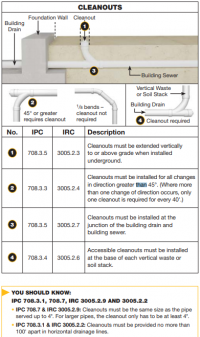Plumbing Design Guide
Jump to navigation
Jump to search
![]() Hint: You can learn plumbing by building our DIY house - See Seed Eco-Home 4
Hint: You can learn plumbing by building our DIY house - See Seed Eco-Home 4
Concept
Vents next to traps are allowed only a limited length. You must reach a dry stack to be 'home free'. The dry stack can be any length - it is effectively as if the appliance is connected to the outside. The purpose of traps is to trap odor, the purpose of vents is to prevent water from being siphoned out of the trap.
SH7 Plumbing Design Guide
- Study the layout - [1]
- Study the build cheatsheet for plumbing - [2]
- Examine as-built pictures from SH6 for build detail - [3]
- Shower is 31.5" wide, fits full width of bathroom
- Toilet center of drain - must be a minimum of 15" from shower and vanity
- Toilet center of drain - must be 12" from wall behind toilet
- Vanity and shower drains go up from floor
- Shower drain must have allowance for p-trap under tubs/showers
- P-traps for sinks are inside the vanity (above floor)
- Vanity is 61" long
- Place plumbing in middle of vanity
- Offset shower drain from center (16") to the side, to 24" from wall edge of tub
- Start with 2" drain for kitchen sink
- Transition to 3" for bathrooms after Shower 1
Working Doc
Drain Design
- Pressure test valves, cleanouts, sizes and types of pipes for each main group, well-illustrated - [4]. Ex - washer fixture drain must empty into a 3" horiz or vert.
- This is useful:
- Note that quarter bend is not same as vent elbow.
Cleanouts
- One required at junction of building drain and sewer line - unless it's 10' within of another cleanout inside house.
- Cleanout must allow for cleaning downslope
- Cleanout required at base of stack
- Cleanout required for every 90 degree turn, but only one is required if there are multiple turns if the developed length is 40 feet or less.
Design
- Heater drain pan drain size minimum 3/4" - [5]. Note: can drain pan be avoided if AHJ approves direct discharge of T-P valve into indirect drain?
- Washer standpipe height - no more than 30" above trap weir, no less than 18 [6]
- Wye is not allowed in venting, only sanitary tee. [7]. This applies to the main stack connection for second floor of SEH.
- Vertical may not count in developed length when considering horizontal developed length - [8]
- Changes of direction (bends) require specific fittings depending on whether the bend is vertical or horizontal. IPC Table 706.3 specifies this. Residential code of Kansas - P3005.1
- When to use Wyes vs Tees - [9]
- When to use double wye vs double tee -
- 4 to 3 inch closet bend is standard - but after that a long sweep is not required - can use a regular elbow - [10]
- Washing machine horizontal must be 4" after 2" trap. [11]. Note that modern washers have a very fast drain rate.
- Stack Vent shall be same size as soil pipe of which it's an extension - [12]
- 2" trap must be 8' from vent, 1.5" must be 6' from vent. p. 18 of [13]. Washer needs 2" by UPC.
- Circuit venting classifies 4" drain pipe as a horizontal vent, under the assumption that circuit is never more than at half-full capacity of 4" pipe. See p. 14 at [14]. Circuit venting means multiple fixtures with a common vent.
- AAV inlet must be at least 4" above the horizontal it serves. [15]. But, still need one vent to outside even if you have AAVs.
- Vent to drain distances included. Island venting. Air admittance valves. Engineered vent with sump pump and air admittance - like under sink macerator pump. [16]
- Drainage fixture unit - DFU - 7.5gpm or cubic foot of water through 1.25" pipe. Table for appliances and DFUs - [17]. DFUs based on pipe size - 2" is 6 DFUs - [18]
- Vents are 10' away from windows or air intakes, or 3 feet above. [19] Must be >10' above ground. [20]
- Good openslides on basics - [21]
- Vent stack vs stack vent - a stack vent is required in addition to vent stack for 5 stories or more [22]
- Island venting - for example an island sink as in this video - [23] - you can use an air admittance valve, or you can use an island fixture vent loop.
- Vent exends 6" above roof, except if roof is used for purposes other than weather protection - in which case it's 7'. [24]
- Vent is half diameter of drain served. [25]
- Washing machine needs a trap - [26]
- Vent stacks can run up the side of a house - [27]
- Total vent cross sectional area must equal total drain cross sectional area. See point 6 at [28]. Note that air admittance valves add to the total cross sectional vent area.
- 1/8" slope per foot is acceptable for 3" pipe - [29]
- "Once the highest branch interval is connected to the stack, the vent portion may contain offsets, provided such offsets are at least 6 inches above the branch interval connection. p. 11 in [30]
- We would like to use wet venting to save on the number of pipes required in the overall plumbing system. p. 12 of [31]. However, we cannot wet vent between floors as the velocity of water can cause traps to suck out [32]. Thus, we have limited options for wet venting.
- Minimum vent size is 1.25", but some cities require 1.5" such as NYC - [33]
- Code says vent stack size must be 1/2 size of waste pipe.
- Difference between wet vent and combination waste and vent system - [34]
- Individual Vent must be 1/2 diameter of drain it serves, but no less than 1.25" [35]
- Wet venting rules [36]. The bottom line is that the toilet must be the bottom line.
- Line color is not required to match water temperature. [37]
- Water hammer arrestor is not necessary for PEX - [38]
- Air Admittance Valves can vent multiple fixtures on the same floor [39]. Note that washer trap must empty into a 3" horizontal?
- Tracer wire shall be used for water supply [40].
- Toilet Rough-In - [41]. In our case 10" above floor for water, which is a uniform water line height in utility channel, which clears floor of cabinets (6").
Inspection
External Links
Sources
 2021 UPC online - [44]
2021 UPC online - [44]
Links
- Common Exhaust Chimney (A Concept Wherein All the Vent Pipes are Connected to a Central Outlet (Essentially like how there is one Black Water out, not 50 different pipes out
- House Design Guide
- Plumbing Library
- Plumbing Inspection

